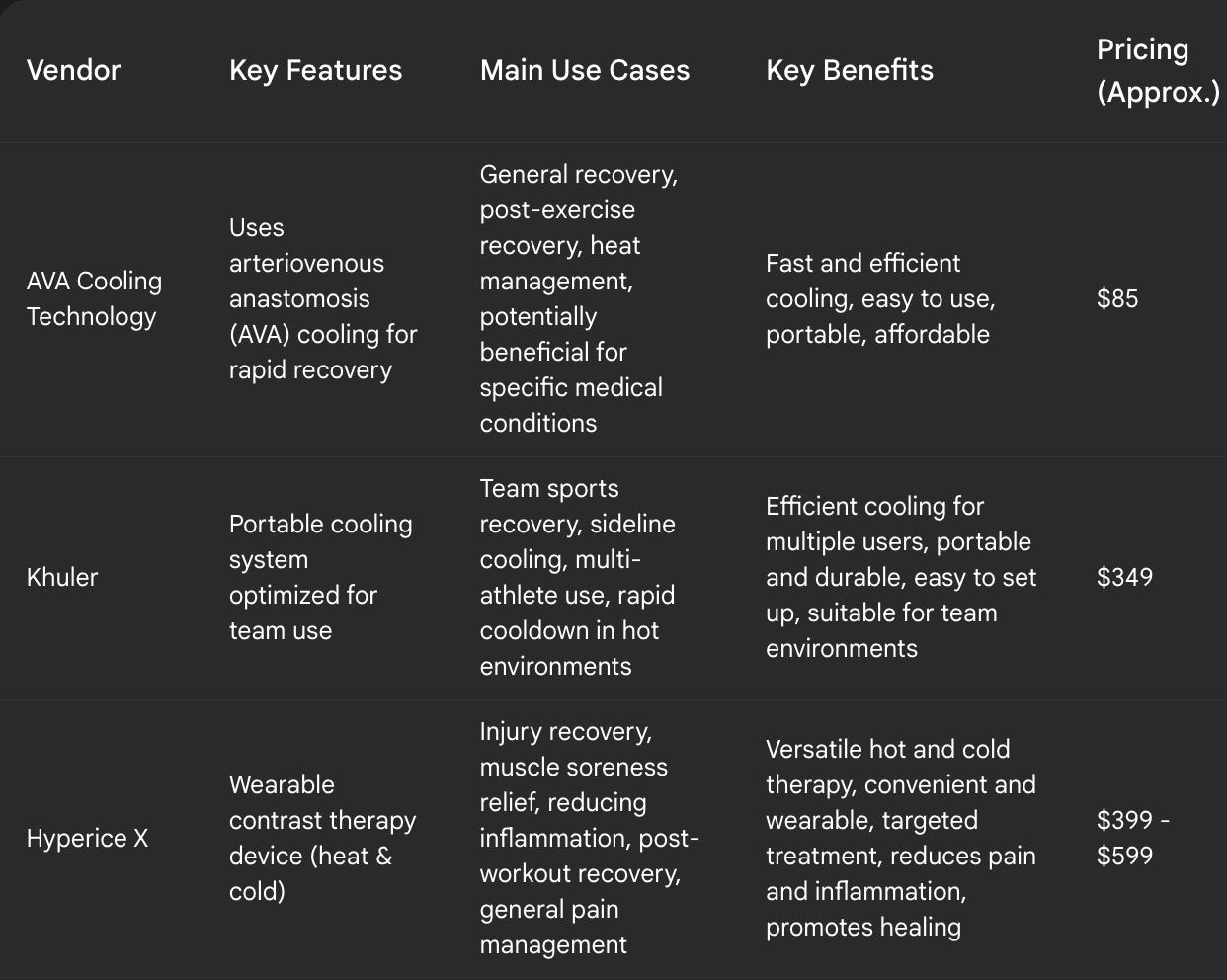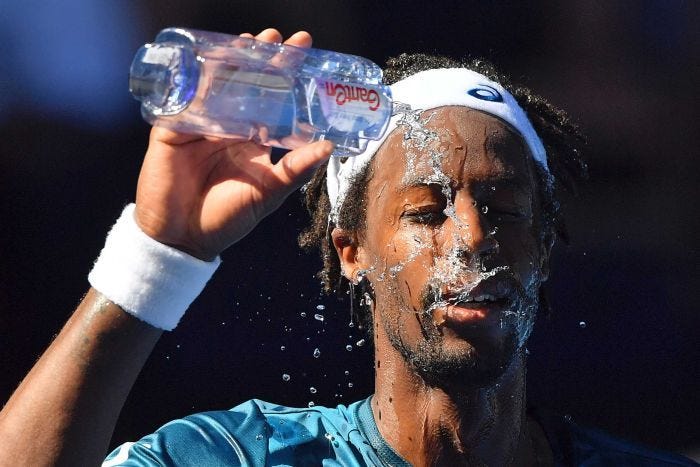❄️ Upside Analysis: The Cooling Therapy Device Vendor Ecosystem: Key Drivers, Challenges, Use Cases, Vendors, and Recommendations to Pro Teams
Cooling therapy has become a critical component of athlete recovery, injury prevention, and performance optimization in elite sports. With advancements in technology, cooling devices are now more efficient, portable, and accessible, with 85% of professional sports teams in the NFL, NBA, NHL, and European football leagues using some form of cooling therapy today. This report analyzes the current cooling therapy device vendor ecosystem, covering market size, key drivers, challenges, use cases, adoption rates, major vendors, and strategic recommendations for professional teams.
Market Size
The global cooling therapy market is experiencing substantial growth, driven by increased adoption in elite sports, medical applications, and general wellness. As of 2024, the market is valued at approximately $3.5 billion and is projected to grow at a CAGR of 6.8% over the next five years. The increasing demand for performance enhancement and faster recovery in professional sports, along with rising awareness of the benefits of temperature regulation, is fueling this expansion.
Regional Market Insights
North America: Dominates the market with over 40% market share, driven by the widespread use of cooling therapy in the NFL, NBA, NHL, MLS, and NCAA.
Europe: Growing adoption in Premier League soccer clubs, cycling, and endurance sports, with increasing investment in sports science and recovery technology.
Asia-Pacific: Rapid market expansion fueled by the rise of professional leagues and investment in Olympic and Asian Games training programs.
Rest of the World: Emerging markets in Latin America and the Middle East are beginning to incorporate cooling therapy into high-performance sports training.
Key Benefits
Enhanced Athletic Performance & Recovery: Cooling therapy helps in reducing muscle fatigue, improving endurance, and expediting recovery in elite sports.
Injury Prevention & Rehabilitation: Cold therapy is widely used for treating injuries, reducing inflammation, and accelerating the rehabilitation process.
Key Drivers
Scientific Backing & Technological Innovation: Research on thermoregulation supports its effectiveness, leading to increased trust and adoption by professional teams.
Adoption in Healthcare & Wellness: Beyond sports, cooling therapy is gaining traction in healthcare for post-surgical recovery and chronic pain management.
Regulatory & Compliance Support: Increased focus on athlete safety and recovery protocols by regulatory bodies supports wider adoption.
Customization & Personalization: Teams and athletes can now tailor cooling protocols to their specific needs, further increasing adoption.
Advancements in Portable and Wearable Technology: New compact and wearable cooling devices allow for easier in-game and on-the-go application.
Key Challenges
Limited Awareness & Education – Many teams lack proper knowledge about the technology's benefits and correct application.
Device Usability & Portability – Some devices are not optimized for on-the-go usage, limiting their practicality in competitive environments.
Variation in Effectiveness – Individual responses to cooling therapy vary, requiring teams to experiment with different devices and techniques.
Integration with Existing Recovery Protocols – Teams often struggle to incorporate cooling therapy seamlessly into their recovery and performance plans.
Regulatory Approvals & Compliance – Some markets require extensive certification, delaying product rollouts.
Perceived Alternative Solutions – Some athletes and trainers still favor traditional ice baths over newer cooling technologies.
Main Use Cases
Pre-Game Cooling – Used to lower core body temperature before competition to improve endurance.
In-Game Recovery – Quick cooling to maintain optimal performance, especially in endurance sports.
Post-Exercise Recovery – Reducing inflammation and muscle soreness after training or competition.
Injury Management – Applied in treating acute injuries such as sprains, strains, and muscle tears.
Rehabilitation & Medical Applications – Used in post-surgical recovery and pain management for athletes.
Military & Tactical Applications – Special forces and military personnel use cooling therapy for endurance enhancement in extreme conditions.
Corporate & General Wellness – Adoption of cooling technology in office settings and wellness centers to improve cognitive performance and reduce fatigue.
Key Stats and Adoption Rate in Elite Sports
85% of professional sports teams in the NFL, NBA, NHL, and European football leagues use some form of cooling therapy.
60% of NCAA Division I teams have integrated cooling devices into their training and recovery protocols.
Research indicates a 4-6% improvement in endurance and a 30% reduction in recovery time with effective cooling strategies.
Elite marathon runners and cyclists widely use pre-cooling techniques to optimize race-day performance.
50% of Olympic training centers worldwide now include cooling therapy as part of their official recovery protocols.
Soccer teams in the English Premier League and La Liga have invested over $20 million collectively in cooling technology research and adoption in the last five years.
Key Vendors
The key vendors described in the table below are devices used for performance enhancement just before and during competition, training, or work (pre and per cooling).
Picture: Upside Global, 2025
Vendor Analysis
AVA Cooling Technology: Specializes in AVA-based cooling, which effectively regulates body temperature for optimal performance and rapid recovery. Its affordable ($85) advanced technology is used by elite sports teams and military organizations.
CoolMitt: A compact and portable device ($1100, now $995) that focuses on palm-based cooling, helping endurance athletes reduce heat stress and improve overall performance.
Kuhler: Offers high-performance cooling solutions ($349) designed specifically for team sports. Its portable units provide efficient cooling without requiring extensive setup.
Hyperice X: A wearable contrast therapy device ($399-$599) that alternates between heat and cold, ideal for dynamic muscle recovery and pain relief for professional athletes.
Game Ready: Combines active compression and cold therapy ($3500-$6000) for treating sports injuries, reducing swelling, and accelerating the healing process.
CoreControl: Features a rapid cooling glove ($1200 - $2500) designed to enhance endurance by preventing overheating and optimizing body temperature control.
ThermoTek: Offers medical-grade cooling and compression systems ($4000+) used for both sports rehabilitation and clinical applications.
NICE Recovery: Integrates cold therapy ($975) with compression for optimized athletic recovery. Its systems are widely used in professional leagues and Olympic training centers.
APEX Cool Labs: offers advanced cooling technology for athletic recovery, optimizing temperature regulation to reduce fatigue and enhance performance. Priced at $200, it provides an affordable, effective solution for athletes at all levels, helping speed up recovery and maximize potential.
Key Recommendations to Pro Teams
Adopt a Multi-Modal Cooling Strategy – Combine pre-game, in-game, and post-exercise cooling techniques for maximum benefit.
Invest in Portable and Versatile Devices: Select cooling solutions that are easy to integrate into training and competition environments. For example: AVA Cooling Technology’s AF Charge Bar.
Educate Athletes and Staff – Provide training on the proper use of cooling devices to optimize performance and recovery.
Leverage Data & Research – Use performance tracking tools to assess the impact of cooling therapy on individual players.
Consider Cost-Benefit Analysis – Evaluate the return on investment (ROI) by comparing device costs against performance improvements and reduced injury rates.
Customize Cooling Protocols – Work with sports scientists and medical staff to develop athlete-specific cooling strategies.
Explore Partnerships with Vendors – Partner with cooling technology providers for team-specific customization and sponsorship deals.
Integrate Cooling into Broader Recovery Plans – Use cooling therapy in conjunction with other techniques like cryotherapy, massage, and hydration strategies.
Conclusion: Cooling therapy has evolved into a crucial component of elite athlete performance, recovery, and injury management. With increasing scientific backing and technological advancements, adoption rates continue to grow across professional sports, NCAA programs, and Olympic training centers. However, challenges such as high costs, usability concerns, and education barriers remain. Professional teams should focus on a multi-modal approach to cooling, leveraging a mix of wearable and high-performance systems while integrating data-driven recovery strategies. By investing in the right cooling technology and educating athletes and staff, teams can enhance performance, reduce injuries, and gain a competitive edge in high-stakes environments.
You may also like:
💦Upside Analysis: The sweat and heat sensing market
Monitoring and analyzing sweat and heat is one of the most complex areas of biometric sensing. This has become extremely important as athletes are sometimes exposed to very high temperatures.
🧊Upside Chat with Bill Donovan, CCO, CoolMitt, a Pioneer Manufacturer of Cooling Devices for People that are Heat Stressed.
This week, we have the honor to interview Bill Donovan, Chief Commercialization Officer at CoolMitt, a pioneer manufacturer of cooling devices for people that are heat stressed.
🎙️ Upside Chat with Stefan van der Fluit, CEO of FLOWBIO, a Leading Company that Deletes Dehydration for Athletes
Today we have the honor of interviewing Stefan van der Fluit, CEO of FLOWBIO, a leading company that deletes dehydration for athletes.
















